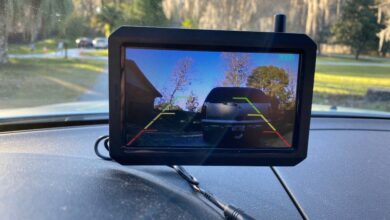Optimizing Video Surveillance with Frigate HWAccel_Args for QNAP Virtual Machines

In network video recording (NVR), hardware acceleration through hwaccel_args in a QNAP virtual machine setup with Frigate software significantly advances video processing efficiency. This article delves into the specifics of configuring Frigate’s hwaccel_args to leverage GPU capabilities within QNAP virtual machines, enhancing the performance of video surveillance systems.
Understanding Frigate and Hardware Acceleration
Frigate is an open-source NVR solution that implements real-time object detection using AI technologies. When integrated into QNAP virtual machines, Frigate can utilize hardware acceleration to offload video processing tasks from the CPU to the GPU, ensuring efficient video analysis without overloading system resources.
Hardware acceleration is crucial in high-demand video processing scenarios as it allows for smoother video playback and more responsive monitoring systems. In QNAP environments, this means configuring the hwaccel_args properly to ensure that the system’s GPU effectively handles video decoding tasks.
Setting Up Frigate HWAccel_Args for QNAP Virtual Machines
The configuration of hwaccel_args within Frigate involves several technical steps that can significantly impact the performance and reliability of video surveillance setups:
- Enable GPU Passthrough: First, ensure the QNAP system supports GPU passthrough. This feature is essential as it allows the virtual machine direct access to the GPU, a prerequisite for adequate hardware acceleration.
- Configure Frigate’s HWAccel_Args: Modify Frigate’s configuration file to specify which GPU to use and detail the workload the GPU should handle. This process involves setting the correct parameters to instruct Frigate to delegate video decoding tasks to the GPU.
- Test and Monitor: After configuring the hwaccel_args, it is crucial to test the system to ensure that the GPU is being utilized correctly. Monitoring tools can help verify that the CPU load is reduced and that the GPU efficiently handles video processing.
Benefits of Using HWAccel_Args in Frigate
Implementing hwaccel_args in your QNAP virtual machine setup with Frigate offers several advantages:
- Reduced CPU Load: By offloading video processing to the GPU, the CPU is freed up to handle other operations, which can improve the overall responsiveness and stability of the system.
- Enhanced Video Performance: Hardware acceleration allows for higher-quality video playback with fewer dropped frames and reduced latency.
- Scalability: With reduced CPU load, it becomes feasible to scale up the surveillance system by adding more cameras without a proportional increase in hardware resources.
- Energy Efficiency: GPUs are generally more efficient at processing video than CPUs, leading to potential reductions in power consumption.
Practical Steps for Configuration
Configuring hwaccel_args requires a detailed approach:
- Verify Hardware Compatibility: Check that your QNAP model supports GPU passthrough and has a compatible GPU.
- Edit the Config File: Access Frigate’s config file to set hwaccel_args, specifying details like the GPU device ID and the type of acceleration (e.g., CUDA for NVIDIA GPUs).
- Optimize Settings: Depending on your specific surveillance needs and hardware setup, you may need to tweak these settings to find the optimal balance between performance and resource utilization.
Common Challenges and Troubleshooting
Configuring hardware acceleration has its challenges. Users may encounter issues such as incompatible hardware or incorrect settings, preventing the system from performing as expected. Troubleshooting steps include verifying hardware specifications, reconfiguring hwaccel_args, and consulting online forums or professional support to resolve complex issues.
Conclusion
The integration of Frigate hwaccel_args in QNAP virtual machines offers a robust solution for enhancing the performance of video surveillance systems. Users can achieve a highly efficient, scalable, and responsive surveillance environment by configuring hardware acceleration. As video processing demands continue to grow, leveraging the power of GPU acceleration will become increasingly important in maintaining an effective surveillance system.
FAQs: Frigate HWAccel_Args for QNAP Virtual Machines
What is Frigate?
Frigate is an open-source Network Video Recorder (NVR) that analyzes video feeds using real-time object detection with artificial intelligence.
What are hwaccel_args in Frigate?
hwaccel_args are parameters used in Frigate’s configuration to enable hardware acceleration, directing the software to use specific hardware components like GPUs to process video data, which can significantly improve performance by reducing CPU load.
Why use Frigate on a QNAP virtual machine?
Using Frigate on QNAP virtual machines allows users to leverage powerful network-attached storage devices for efficient video surveillance management, taking advantage of QNAP’s robust hardware to enhance video processing and storage capabilities.
How do I configure hwaccel_args in Frigate?
Configuration involves editing Frigate’s config file to specify the GPU device and the type of acceleration required. Depending on your hardware setup, this could include setting arguments to use specific video codecs or GPU capabilities.
What common issues might I face when setting up hwaccel_args, and how can I troubleshoot them?
Common issues include incompatible hardware, incorrect configuration settings, and performance bottlenecks. Troubleshooting these problems typically involves verifying hardware compatibility, revising configuration files, or consulting online forums and support for guidance.
You May Also Read: FutureTechGirls Kickass Tips: Empowering Women in Technology



